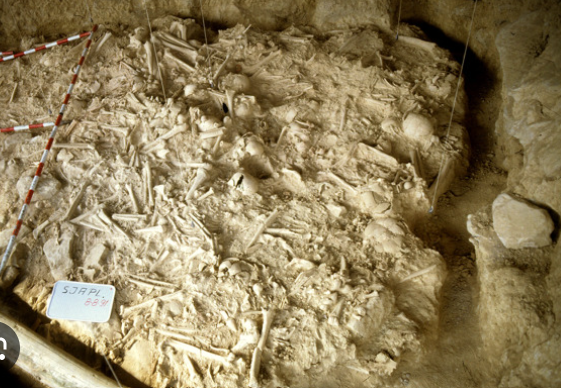War
There is a body of thought that warfare did not exist amongst early human populations but was something that started when populations got to such a size that there was active competition for resources and a technology developed that facilitated it.
War was thought to be an exclusively human activity however, this is longer the case. A famous study by Jane Goodall in the 1970s documented the Gombe chimpanzee war (1974 - 1978), when a tribe of chimpanzees split into 2 factions and moved to separate parts of the forest. What followed was a boarder war characterised by one group attacking the other, killing and then celebrating the killing. The war only stopped after 4 years when the members of one group had all been killed.
The existence of war in prehistory (the Neolithic and beyond), is a difficult thing to prove. War is an activity rather than an object.
There is undoubted archaeological evidence of violent death at the hands of other humans. Skeletons with arrowheads stuck in them, evidence of various force trauma, but these could be the result of a feud or murder rather than war. Studies have shown that in Neolithic society a lot of people died a violent death. One well documented study (Petrasch 1999) concluded that 20% of individuals found, died as a result of violence.
But war is different to other types of violence because it is an organised activity, approved by a society and directed towards another group (Otterbein 1994). Evidence of warfare has been found at San Juan in Northern Spain, where a 5kya burial pit contained the bones of hundreds of, mostly male, individuals who predominately died from being stabbed and blunt force trauma. In amongst the bones were many stone weapons including blades, arrowheads and axes. Archaeologists believe the site to be the result of a sustained conflict that was added to over time.
Whilst there are a variety of reasons for going to war, the list has been consistent through recorded history and it seems reasonable to extend it into pre-history. The list includes defence, revenge, territory and plunder, glory, and the subjugation of perceived rivals. The impact of war maybe directly related to the technologies involved. The weapons used have a big impact but so do associated technologies needed to transport and supply combatants. Things such as the ability to create and communicate a plan, the existence of roads and the ability to store and carry food, all impact the number of combatants involved, their ability to coordinate and the amount of time they can spend conducting warlike activities.
The simplest weapon is a rock. Attach the rock to a stick and you have a mace. Put a sharpen rock on a stick and you have an axe. Each step represents technological progress. In addition to axes, shields, slings, mace, spears, it is the bow and arrow that represents the greatest technological leap. The ability to kill at distance, using a lightweight weapon is important when hunting, but also in the ability to wage war. Neolithic bows were typically simple affairs made from the core of a Yew tree and strung with sinew. Arrows were carved and tipped with flint arrow heads. Further advances included the development of composite bows, triangular arrowheads and wrist guards.
The development of such weapons were accompanied by other developments in the form of agricultural tools. These advances resulted in a more settled lifestyle than that of the traditional of hunter gather. These were the driving force that moved the Paleolithic world forward into the Mesolithic and Neolithic.
Questions remain, such as which came first?
Was it the ability to generate a food surplus food via the new science of farming that necessitated the need to defend that surplus?
Or was it that weapons allowed fixed areas of ground to be better defended, so encouraging people to stay put and invest in their patch of land?
That's one of the great things about Paleo-Anthropology, it all down to a very limited and haphazard supply of evidence that we, as a humans, can put into a pattern that makes sense.


